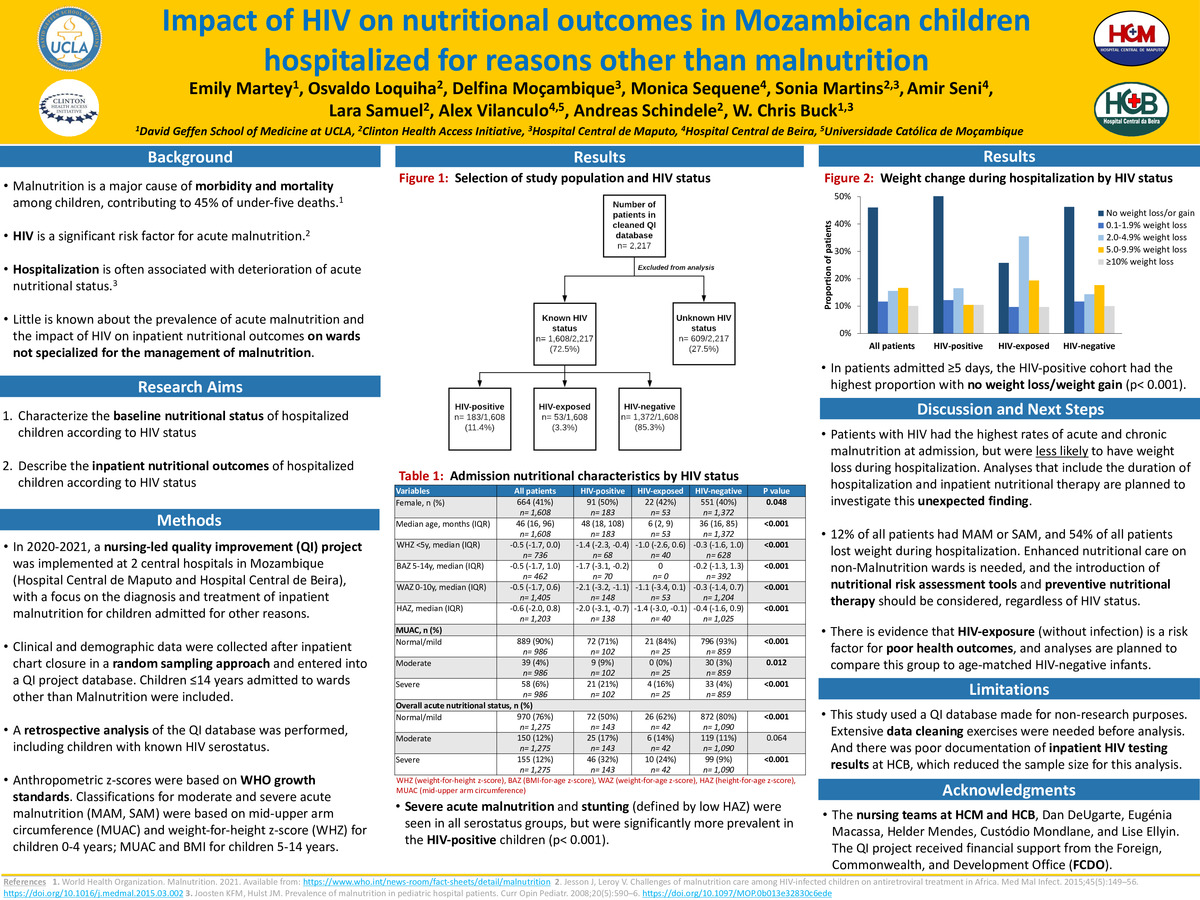-
Author
Emily Martey -
PI
W. Chris Buck, MD, MSPH
-
Co-Author
Osvaldo Loquiha, Delfina Moçambique, Monica Sequene, Sonia Martins, Amir Seni, Lara Samuel, Alex Vilanculo, Andreas Schindele
-
Title
Impact of HIV on nutritional outcomes in Mozambican children hospitalized for reasons other than malnutrition
-
Program
Global Short-Term Training Program
-
Other Program (if not listed above)
-
Abstract
Background
Malnutrition is a major cause of morbidity and mortality among children, contributing to 45% of under-five deaths. In Mozambique, 6% of children under 5 years of age suffer from acute malnutrition. HIV and hospitalization are two significant risk factors for acute malnutrition. Most of the literature on pediatric malnutrition and HIV in hospitalized children from sub-Saharan Africa has been from inpatient wards specialized for the treatment of malnutrition. Very little is known about the prevalence of acute malnutrition and the impact of HIV from other pediatric wards where children are admitted, primarily, for reasons other than malnutrition.
Methods
From January 2020 – February 2021, a nursing-led quality improvement (QI) project focused on nutritional screening and treatment was implemented on pediatric wards other than the Malnutrition wards at two large referral hospitals in Mozambique (Hospital Central de Maputo and Hospital Central de Beira). Clinical and demographic data were collected after inpatient chart closure (discharge, transfer, or death) in a random sampling approach and entered into a QI project database. This study was a retrospective analysis of the QI database, limited to children ≤14 years of age with known HIV serostatus. Anthropometric z-scores were based on WHO growth standards. For children <5 years, classification of acute nutritional status was based on mid-upper arm circumference (MUAC) and weight-for-height z-score (WHZ). For patients 5-14 years, MUAC and body mass index (BMI) were used. Descriptive statistics were used to report nutritional outcomes, with Pearson chi-squared test and Kruskal-Wallis rank test used to compare medians and proportions, respectively.
Results
Of the 2,217 hospitalized children included in the cleaned QI database, 1,608 had known HIV status upon chart closure. Eleven percent (183/1,608) of patients were HIV-positive, 3% (53/1,608) were HIV-exposed, and 85% (1,372/1,608) were HIV-negative. The median age of the cohort was 46 months (IQR 16 – 96) and 41% were female. The prevalence of stunting (low height-for-age z-score, HAZ) and severe acute malnutrition at the time of admission was highest in HIV-positive children (p< 0.001). Baseline stunting and severe acute malnutrition were also more prevalent in HIV-exposed compared to HIV-negative children (p< 0.001). In the total cohort, 12% of patients had moderate or severe acute malnutrition at admission. Over half (54%) of patients admitted for ≥5 days lost weight during hospitalization, with the HIV-infected cohort least affected and the HIV-exposed cohort most affected (p< 0.001).
Conclusion
Acute malnutrition is common in children admitted to the hospital for reasons other than malnutrition, with higher prevalence in HIV-positive and exposed children. Weight loss during hospitalization is also common, with HIV-exposed infants being most affected in this study. Enhanced nutritional care on non-Malnutrition wards is needed, and introduction of admission nutritional risk-assessment tools and preventive nutritional therapy should be considered, regardless of HIV status.
-
PDF
-
Zoom
https://uclahs.zoom.us/j/97226123731?pwd=NEhidjB3UUxIMDF2MTFqM1c1MnU2QT09

